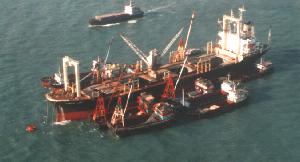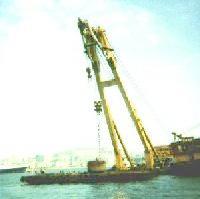
In Hong Kong, some cargo handling takes place with vessels at mooring or at anchor. This is known as "mid-stream operation". There are 11 'A' class and 4 'B' class moorings mostly laid within the port of Hong Kong. The mooring buoys are owned and managed by Marine Department and they are also known as government mooring buoys.

'A' class moorings are suitable for vessels of a length overall not exceeding 183 metres (or in some cases, not exceeding 160 metres) and 'B' class moorings for vessels not exceeding 137 metres.
A vessel must use its chain cable to secure to a government mooring. The slip wire, which is an aid to mooring and unmooring, must remain slack at all times when the weight of the vessels is taken up by the chain cable. Cargo lighters are permitted to lie alongside vessels in the stream but not more than 3 abreast on any side of the principal vessel.
Government Mooring Buoys Booking and Allocation Procedures
- Owners, agents and charterers of vessels requiring the allocation of government mooring buoys can apply according to the following procedures:
- Applications for the allocation of a government mooring buoy should be made to the Vessel Traffic Centre (VTC) by facsimile (number: 2858 6646) adopting the format of the Buoy Requisition Form . Full information should be provided in all applications and any subsequent amendments should be made using the same format, which should be headed "Amendment".
- An application for a government mooring buoy cannot be accepted earlier than 48 hours before the estimated time of arrival (ETA) of a vessel. VTC receives application twice a day, namely from 1000 hours to 1700 hours (first batch) and 1800 hours to 0900 hours (second batch). VTC will allocate buoys at about 1000 hours and 1700 hours.
- Government mooring buoy dues are charged in accordance with the Shipping and Port Control Regulations and will commence when a buoy allocation is formally effected by VTC, see (f) below, and will continue until the vessel finally vacates the buoy.
- If a vessel, having occupied a government mooring buoy, wishes to temporarily leave that buoy and to subsequently return to it, permission to do so should be requested from VTC by facsimile, see (a) above, as soon as possible and, in addition, the request should be made through the VHF Radiotelephone prior to leaving the buoy.
- A request for an extension of stay at a government mooring buoy should be made at least 4 hours before the original estimated time of departure from the buoy to VTC by facsimile adopting the format of the Buoy Occupation Extension Form.
- Allocation of a government mooring buoy will normally be deemed to have been formally effected when a facsimile confirmation from VTC has been returned to the applicant.
- The applicant may reject the allocation of a government mooring buoy, within an hour from the time the buoy allocated by VTC, by facsimile adopting the format of the Rejected Buoy Allocation Form.
- In May each year, in advance of the commencement of the typhoon season, the Director of Marine will promulgate a Marine Department Notice (MDN) detailing those government mooring buoys for which vessels moored to it shall clear anchors and cables and prepare the main propulsion machinery to full power conditions.
- Subsequent to the hoisting of No. 1 Tropical Cyclone Warning Signal, removal notices will be served on those vessels occupying government moorings buoys listed in the MDN, and vessels whose length overall exceeds 113 metres occupying "B" class moorings. Vessels are required to comply with such notices and leave the government mooring within two hours following the hoisting of the No. 3 Tropical Cyclone Warning Signal.
- Subsequent to the hoisting of No. 3 Tropical Cyclone Warning Signal, applications of government mooring buoy for routine purposes will not normally be accepted nor allocations made except in special circumstances, such as vessels in the care of dockyards and vessels without means of propulsion. In such cases, subject to length limitations, a vessel may apply for a mooring provided she can be secured to the buoy by suitable anchor chain cable. In this context, suitable anchor chain refers to chain cable meeting classification society requirements for the size of the vessel concerned.
- Buoy dues are levied by the Department on vessels using government moorings.